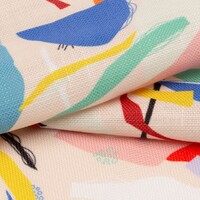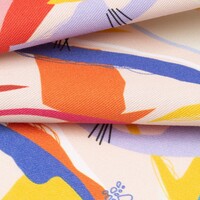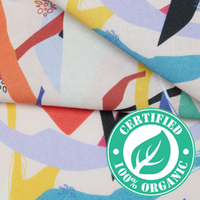Related:
Back to Site Stores ({{popupVm.storeTotalCount}})
Artists ({{popupVm.artistTotalCount}})
Browse our handpicked range of materials to print your own lampshade fabric. Upload photos, designs, and t...
Read MoreShips In 1 - 2 days
Delivery: $12.95
Handmade
Soften up a harsh light with custom fabric lamp shades.
Browse our range of lampshade fabrics
Soft, Matte, Woven, Poly. Linen look. Coarse weave, large fibers. Off white base. Not totally Opaque. Great for craft projects. Use: coats / garments, soft furnishing, craft projects, cushions
100% polyester
100% cotton, classic Twill. 3/1 Twill weave. Medium weight, great for outer garments, light upholstery.
100% cotton
Basic plain weave, dyed white cotton calico. A simple cotton, dyed white for optimal color.
100% cotton
90% PVC, 5% Polyester, 5% Cotton. Durable "leather" stamp effect leatherette. 30k Martindale rub test for durability, BS5852 cigarette & match FR test for UK domestic furnishings. Waterproof (BS3424.5A).
90% pvc, 5% polyester, 5% cotton
Elegant, stylish and utterly sumptuous short piled Chichi Soft Velour. Passes 30k Martindale rub test for durability, passes BS5852 cigarette & match FR test for domestic furnishings.
100% polyester
Plain Weave FR Polyester 145gsm
100% Polyester
Care instructions
Wash at 30°C / 86°F, low tumble dry heat, hang to dry, do not wring, low heat iron.




There are two ways in which to use fabric when creating lampshades; you can either make lampshade fabric, or fabric lampshades. These sound like the same thing, however that is not the case. Some lampshades are made with a frame and fabric, and some are made with a lampshade inner and then a fabric covering. Read more about these methods below. Print your own lampshade fabric with your photos, designs, and text.
This is arguably the simplest way to create custom fabric lamp shades as a DIY project, and can be done in a few simple steps.
Step 1: Choose a base
This can be either a plain lampshade, preferably in white or cream, or it could be a specifically designed inner material for a lampshade. This can be in any size or shape you like, but bear in mind that the more complicated it is, the trickier the later steps will be; you may find it easier to start more simply and then build up to the more complex designs.
Step 2: Make a template
You next need to make a template of your lampshade. This is most easily done by marking the lampshade and starting on that edge. Lay a large piece of paper down and starting at the mark that you created, gradually roll your lampshade across the paper, marking its path as you go, until you are back at your mark again. (If you have a round lampshade, you'll end up with a rectangle, it is more of a cone shape you will have a curved arc) Add approximately 1 centimeter around all of the edges, for when you are finishing your lampshade.
Step 3: Cut your fabric and apply
Using your template as a pattern, cut your customized lampshade fabric to size. Make sure you are happy with the positioning of your pattern on the fabric and its placement. Once this is done you will need to fold up and press the extra centimeter you added around the edges; this will make up a seam. Apply the fabric to your lampshade lining, we would advise using a fire safe fabric adhesive and following the manufacturer's instructions.
Step 4: Finish
Ensure that your seam is stuck down over the edging of the lampshade, and allow it to dry. Spray your lampshade with a fire-retardant fabric spray, again following the manufacturer's instructions, and allow to dry completely. You now have your very own, personalized lampshade made using custom made fabric for lampshade.
Slightly trickier to create, fabric lampshades are made by mounting your fabric onto a styrene backing and applying to a metal lampshade frame.
Step 1: Select your frame and make a template
For this type of lampshade you will be looking for a wire frame, or lampshade rings. A frame will provide the whole of the structure, whereas the rings will provide only the top and the bottom. Using the same method as above, create a pattern for your fabric, using the shade itself as measurements. Remember to add extra all the way around for your seams.
Step 2: Cut your fabric and lining
Using your template you need to cut your fabric and lining to size. Adhesive styrene, or pressure sensitive styrene is one of the most popular materials. It is an extremely thing polystyrene sheet with a sticky side to attach it to your fabric. Any fire retardant, fireproof or fire safe material can be used as a lining, but make sure that you don't use something that may overheat and could cause a fire. With a fire-proof lining, any fabric can be used to make the outside of your lampshade, cotton, silk, and lined are the most popular choices.
Step 3: Piece together
Once all of your pieces are prepared, it is simply a case of putting them together. Remember to glue the seam of your shade together when you create the initial circle. If using a frame simply stretch your fabric and lining over the frame, pin in place and stitch. If you are using lampshade rings the easier way to do this is with bulldog clips; clip your fabric into a circle shape and stand it on its end. Carefully insert the ring into the top and clip into place around the top. Then using either a specially formulated lampshade adhesive, or by stitching, carefully secure your fabric over the ring of the lampshade. Once you have done, over-end it, and do the same to the other end of the lampshade.
Step 4: Finish
Once everything is dry (if you used adhesive) or stitched (if you decided to hand sew) it's time to work on the finishing touches. This involves cutting off any excess, trimming fabrics and threads, and just generally tidying your fabric lampshade up a little so that it all looks perfect. Once this is done your lampshade is ready to be placed on your lamps or light fitting.
When you design custom fabric lamp shades, we use digital printing techniques. Our process uses deep infusion methods to bond the eco-friendly inks deep into the fibers of the fabric. This results in a full color, high-definition print that will not fade away, or peel, scratch, or rub off. The penetration method of creating these fabrics does not affect the handle of the material, leaving behind no texture or residue. This means that the fabric you are left with once your design is on it feels exactly as you would expect the fabric to feel like even if it was plain white and unprinted.
All of our fabrics are printed at 200dpi. This works for us as it combines a great quality as well as a good file weight. In order to avoid resizing and interpolation, we recommend that you scale your image to 100% at 200dpi. Our design interface works with a traffic light system that acts as a quality marker for your designs. This will show you whether the resolution is too low for printing. When you re-upload your design with a highest resolution, the traffic lights will change color, showing you're good to go. A message will pop up alongside the traffic lights to let you know if the resolution is too low or if you have a good quality image.
Your uploaded design will automatically be scaled to fit the size of fabric you've chosen. You can change the dimensions of your fabric by amending the measurements on the ‘Product Options’ tab, under ‘Print Size’. To see how this fits with the dimensions of your image/design, you can refer to the ‘Images & Text Tools’ tab under 'Quality Information'. Here, you will be able to edit the dimensions of the image.
We always recommend using an RGB color space when you upload your images. More specifically, we suggest using the sRGB image profile, to achieve best color results. This will need to be done in your editing software; choose RGB as the working space, and assign the image profile as sRGB (full name sRGB IEC61966-2.1)
There is no length limit for most of our fabrics. Our preview design window is set up to displaying a maximum of 10m (32.8 ft) to help you visualize the print, but that doesn't mean this is the print limit. If you'd like to order more, you can increase the quantity (x2 for 20m or x4 for 40m for example) and order as much as you'd like. Larger volumes will receive an automatic discount too. While the fabric length is nothing to worry about, each individual fabric will have a maximum width side: These can be found on the fabric's page information or in the design interface.
Yes, that will help you when it comes to cutting or framing your printed fabric. We recommend always adding a little extra space for borders into your purchased fabric size. When we print your materials, or send out fabric samples, we typically trim squarely around the fabric, leaving approximately 5mm white space. Cutting neatly on the line has an additional fee.
Crocking is the term used to describe fading along the creases in a fabric. It typically can occur after constant washing or heavy use of digitally printed natural fabrics. Crocking can be minimized by hand washing your fabrics at a cooler temperature, rather than machine washing. If you want to make sure there's no chance of crocking, we'd suggest you use a poly fabric.
Yes, our organic fabrics don't have an additional coating like non-organic fabrics have, which means it absorbs the inks deep into its fiber and reducing the color strength slightly (this can be approximately -40%). If you would like a bolder, more vibrant color for your fabric, we would suggest using a non-organic fabric.
Unfortunately not; all of our fabrics have been tested meticulously to ensure we know exactly how to get the best results, and our facilities cater perfectly to them. If you are set on a fabric we don't offer, we can offer custom printed sublimation paper to order which will allow you to heat press your designs onto your own fabrics.
If your design is simple and less intricate, a JPEG will be absolutely fine. However, if you have created a design with multi-colored detailing, we would recommend saving your design in a TIFF format.
Similar to other fabric printing processes, shrinkage can occur. The amount of shrinkage will depend on the fabric, but as a general rule of thumb, please allow for 2-8% shrinkage when working out your measurements. Shrinkage is not an exact science, and the amount of shrinkage will vary from print run to print run. We'd always suggest order a little more than you need for your project.
Many of the fabrics we offer are semi-transparent, so printing on both sides of the fabric is not a service we offer.
At the moment, all of our fabric labels are printed on satin fabric. For now, we believe this is the best choice, but will potentially introduce other options in the future. All labels are cut to the same label format. If you would like to choose a different fabric and format for your labels, you could always order a sheet of the fabric of your choice to create labels yourself.
Our fabrics are printed with water-based inks as environmental consciousness is always front of our minds. Water-based inks include no chemicals or solvents, and our printing process uses heat to fix colors and patterns into place to avoid excess or contaminated water returning into the water system (this is something that can occur through steaming). All printing, fulfilment and production is done in our one facility, and rather than rolling the fabrics or sending them in a tube, you will receive your material folded up. This amounts to 150 tubes saved a week, as well as much more space on the delivery van for more orders. (For delicate fabrics we ensure to package appropriately).
Although very rare, there could be a slight color difference from one print run to another. This is a normal part of the printing process, however we are always working to improve our color profiles. It is unlikely that the difference in print runs will be hugely different (for example, it's unlikely your orange is suddenly going to be red). The likelihood of color variations can be intensified fabric to fabric due to materials having different grains and textures; natural fabrics typically have more muted color tones, while poly alternatives have a bolder hue. This is because the construction of the material is different, and the printing method has to be altered slightly for more delicate, natural textiles.
Our full cut & sew service at Bags of Love can be used to your full advantage. We even offer hemming for your fabrics at a small additional cost. Our hems are created with a one or two cold hem that typically uses around 5 to 20mm of fabric (depending on the thickness of your chosen material). Please bare this in mind when you are ordering your printed fabric with hems: If you would like your finished piece to be 40" x 40", change your dimensions to 41" instead to allow space for your hems (you will also need to include additional for potential shrinkage). The thicker the fabric, the bigger the hem will be. Your printed fabric will be hemmed with either Black or White thread. If you are ordering a lightly woven material or a printed silk, you will find that one hem will be straight, while the other slightly rippled. The hemming material allowances are as follows and you need to make your print bigger to accommodate the hem:
For further information about our fabrics see our FAQs.
Please note: As everything we provide is handmade to order, you may find a slight variance in the sizes.










